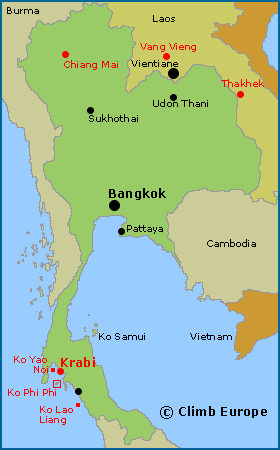Rock climbing in Thailand
Railay and Tonsai in Krabi is the best place to go rock climbing in Thailand, and they have been attracting climbers from all over the world for many years. However there are many other rock climbing areas within the Andaman Sea in Southern Thailand, particularly on the islands where Deep water Soling (DWS) routes have become very popular. The best place to rock climbing in northern Thailand is the Crazy Horse area near Chiang Mai.
Rock climbing at Railay and Tonsai in Krabi
The Krabi area of Thailand is a popular holiday resort, but it is also a world-famous rock climbing destination, and is an excellent tropical sport climbing destination. The limestone cliffs of Thailand’s magnificent Phra Nang peninsula, near Krabi, are home to the famous Railay and Tonsai rock climbing areas. Here there are many excellent single pitch sport routes and some bolted multi-pitch routes most of which are right off the beach in a magical setting. The climbing at Krabi is on pocketed vertical limestone rock, with many tufas and flow-stone formations, in a glorious location by the sea.
It’s worth noting the type of bolts used throughout the Krabi areas. Traditionally these were expansion bolts and stainless steel ring glue in bolts that have a reputation for rusting. Fortunately these are being replaced with Titanium glue in bolts, a process that began in 2011, and as of the end of 2016 over two thirds of the routes have been re-bolted with these titanium bolts.
In addition to the rock climbing at Railay and Tonsai there are many more climbing areas being developed especially in southern Thailand. For example in the Phang Nga bay is the island of Koh Yao Noi, which offers single pitch sport climbing and deep water soloing (DWS). The mountains behind this bay in Phang Nga Province have recently being developed, though there is enormous scope for developing many new routes. Other areas include Ao Nang, Koh Lao Liang, and the island of Koh Phi Phi, which also has some deep water soloing.

Jane climbing Thai Stick, F6b+, at Railay Beach near Krabi in Southern Thailand.
The best time to go rock climbing at Railay and Tonsai in Krabi is from November to March when the weather is dry and warm, which is also the main tourist season. Though it is possible to climb all year round during April and May the weather is extremely hot. The rainy season is from April through to November with September and October the wettest months. During November the rain tails off though whilst it may rain every day it is not for long. February is the driest month. Fortunately the crags at Krabi face east and west, so most climbers chase the shade, starting on a west-facing crag in the morning and moving to an east-facing area in the afternoon.
Rock climbing in northern Thailand
In northern Thailand the main area is around Chiang Mai, particularly the Crazy Horse Buttress area. Here there are more than 170 established bolted routes on brilliantly featured limestone rock. Many of these routes are multi-pitch on steep and overhanging walls. Across the border in Laos the two main rock climbing areas are at Thakheh and Vang Vieng.
Map of the rock climbing areas in Thailand
